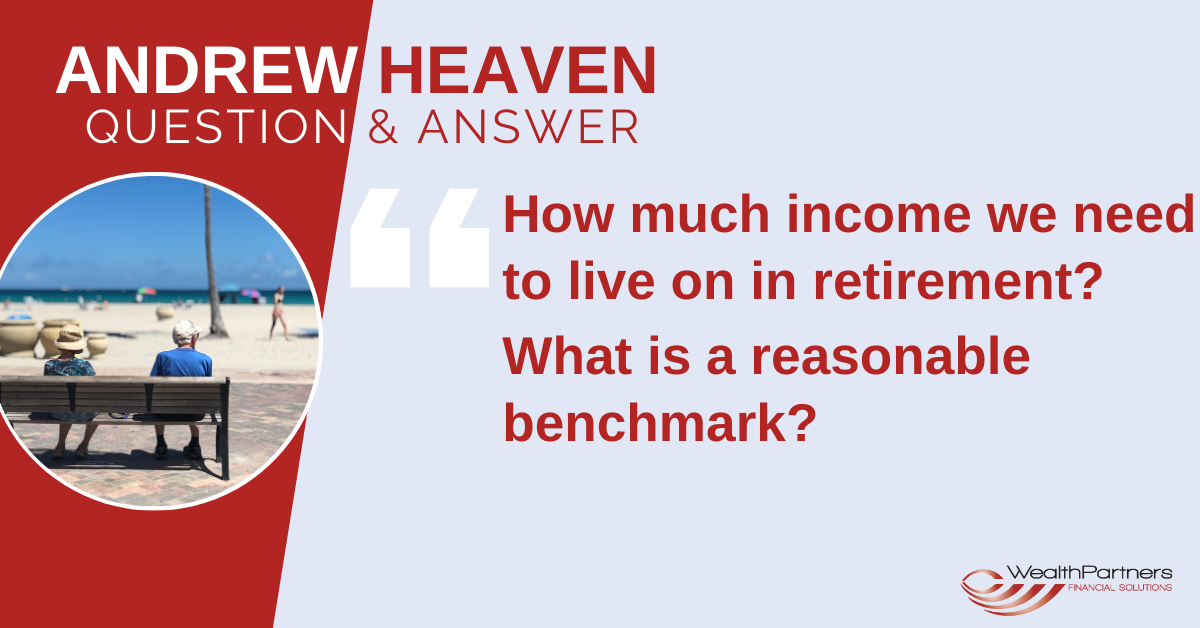Q: My wife and I are in our late 50s and looking to get a clearer understanding of how much income we need to live on in retirement? What is a reasonable benchmark?
A: There really is no definitive answer to your question as everyone’s circumstances and expectations are completely different.
In an attempt to provide guidance on the subject, the Association of Superannuation Funds of Australia (ASFA) have published guidelines on what retirees income expectations should be for a “modest” and “comfortable” retirement.
According to ASFA, a modest retirement lifestyle can provide couples with the basic necessities and limited forms of leisure and luxuries. A modest lifestyle requires couples to keep their spending low and keep to the basics when it comes to household, personal and leisure spending. This means minimal home repairs, limited household items, low utility bills, cheaper cars and infrequent leisure activities.
Should couples wish to take a holiday, they may only be able to afford a holiday within Australia.
They can afford basic private health insurance that has limited gap payments, which means they may still be liable to pay some bills from their pockets.
ASFA forecast that a modest retirement income would be $40,440 p.a for a couple or $27,987 p.a for a single person.
By contrast, a comfortable retirement lifestyle enables retirees to be involved in a broad range of leisure and recreational activities and to have a good standard of living. They will be unconstrained in their ability to purchase household goods when needed. They have private health insurance, a reasonable car, good clothes, a range of electronic equipment, and domestic and occasionally international holiday travel.
ASFA forecast that a comfortable retirement income would be $62,083 p.a for a couple or $43,901 p.a for a single person.
Both scenarios assume that the retirees own their own home outright and enjoy good health.
Whilst ASFA’s analysis provides some level of guidance, it should not be relied upon in entirety. Other factors to take into consideration are; the age at which you retire, your retirement savings balance, your Age Pension eligibility, the annual investment returns you receive and how long you live.
My recommendation is to form a clear view of your own personal income needs for retirement. Identify how much you currently spend on living expenses and determine if there are any changes you anticipate when you retire, for example travel and leisure costs. I recommend you review 12 months of living expenses to form this view.
Once you have a number in mind, test it out by setting this as your monthly budget to confirm your thinking over a twelve month period. This testing period serves two purposes; to confirm the numbers are correct and also confirm you are happy with the lifestyle that the budget provides.
It is not the role of your Financial adviser or ASFA to tell you what income you need in retirement. Everyone’s expectations are different and need to be tailored to your personal needs and objectives. For most retirees this exercise is the most challenging but the most important step to take in planning a financially fulfilling retirement.
Q: How much do we need to have in retirement saving to retire?
A: Retirement planning requires a long-term commitment and discipline to achieve a successful outcome. Many people suggest that at least $1 million is needed in order to retire comfortably however this is not a definitive mark. How much you need in your retirement savings bucket will depend upon the age you plan to retire, what income you expect to need, the returns you receive on your investment assets and how long you live.
Age Pension eligibility is also a critical factor. If your retirement income needs are modest and you qualify for the Age Pension then the amount of capital you require to fund retirement income needs will be a lot less proportionately compared to a self funded retiree with no Age pension support.
The longer you delay drawdown on retirement savings by retiring later has an important impact on your capital needs. The capital required to fund a 35 year retirement could be 1.5 times the capital required to provide the same income over a 25 year period.
The investment rate of return you receive will also have a bearing on your capital requirements. The higher the rate of return you receive will reduce the amount of capital you require to fund. I encourage my clients to be conservative in their expectations of returns to allow them to be more conservative in their investments and reduce volatility in their portfolio.
As a rough rule of thumb, for a self funded retiree, a conservative long term rate of return would be 4 to 5%.
To conservatively estimate your capital needs, assume you are not relying on Age Pension benefits. Divide your income needs by your expected rate of return. For example, if you aim to live on $80,000 a year and you expect a rate of return of 5% a year, then you would need approximately $1.6 million in retirement savings. Do not assume an unrealistic long term rate of return, you are only kidding yourself and exposing yourself to too much risk in pursuing that return.
Note this measure does not take into consideration tax, lump sum capital needs or market risk, however it provides a rough rule of thumb to assist in having that retirement planning conversation.


